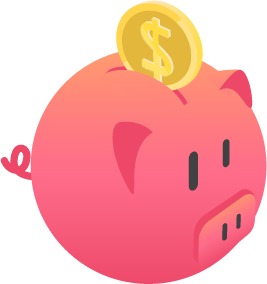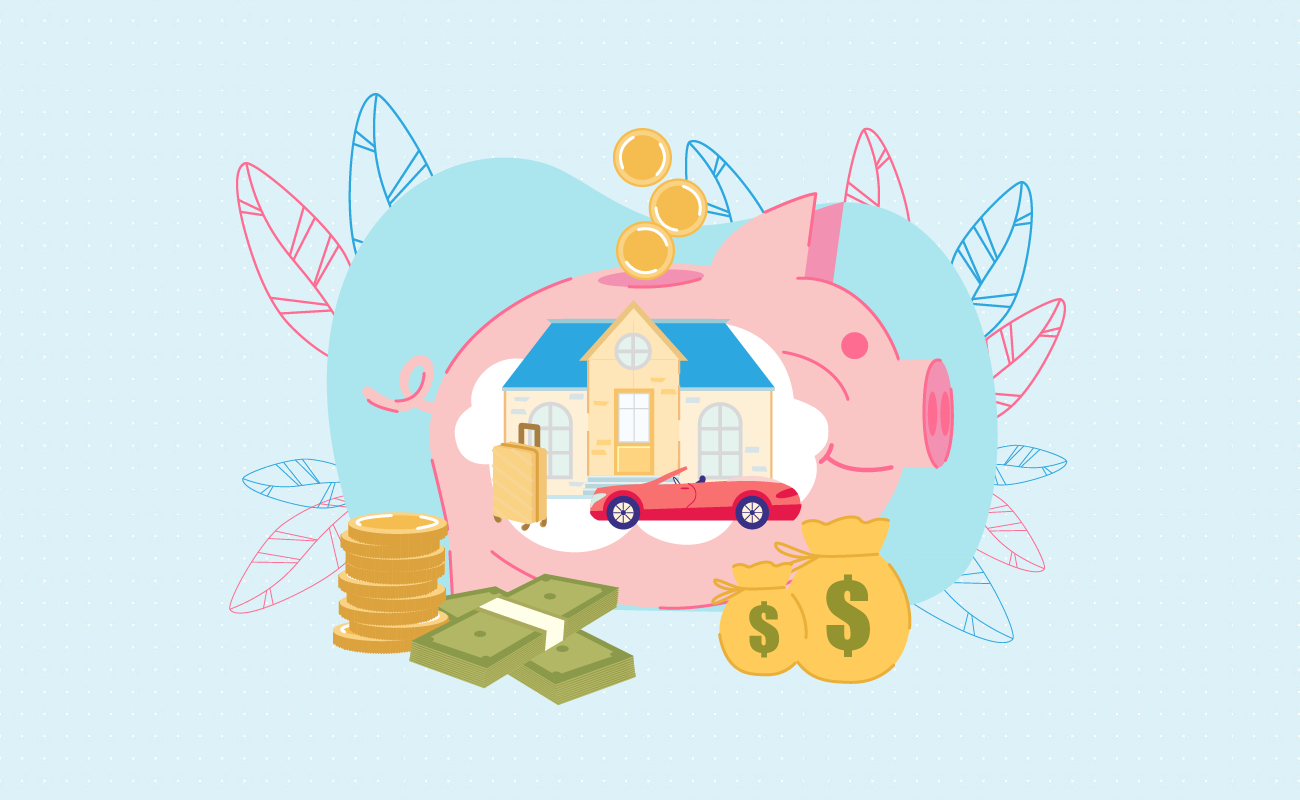Savings Goals
Net Worth
 Periodic Savings Calculator
Periodic Savings CalculatorThis calculator makes it easy to compare the returns of various investment approaches by making it fast to compare APR vs APY for various investment scenarios. Our other savings calculators compound interest as each deposit is made whereas this calculator allows you to track how an investment strategy with regular biweekly or monthly deposits will perform even if the compound interval is daily, quarterly, or annually.
Guide published by Jose Abuyuan on September 25, 2020

In these tough times, saving money should become everyone’s goal. Having some cash for a rainy day can reduce the impact of emergencies. You’ll never know when the next big crisis is going to hit you. Savings will cushion the effects of unfortunate events such as accidents or job loss.
Apart from saving, it’s important to know how to make your funds work for you. Don’t be content with simply hiding your savings away. Put your eggs in several baskets and secure your financial future for years to come.
For several decades, Americans have been one of the most prudent savers in the world. Families put in a lot of money for a rainy day. Today, making such a claim will lead to incredulous looks from some people. From the 1980s to 2004, the rate of personal savings declined from 10 percent to 1.8 percent. Another Federal Reserve study found that more than half of Americans cannot afford a $400 emergency cost.
At present, the United States lags behind in savings. The country ranks 19th among 150 countries in retirement security, according to Natixis Global Asset Management. And America is not alone. Canada, Germany, and Japan have also lagged behind in the savings game, according to the Kansas City Federal Reserve.
The public is also aware of these shortcomings. A study by the Pew Research Center reveals that 63 percent of Americans believe that they don’t save enough.

A common myth is that Americans are inclined to be spendthrifts. Conspicuous consumption has been at the forefront of popular culture, reaching its peak from the 1980s to the early 2000s. To keep up with the Joneses, the average family borrowed more money to buy more things they didn’t need. Houses, boats, cars, cell phones, the list goes on.
It’s easy to conclude that irresponsible spending caused the savings problem. The Atlantic reports that American families could have saved an extra $800 a year if they spent their money wisely. But, as the article suggests, it’s just the tip of the iceberg.
Many factors influence the average person’s ability to save. The biggest obstacle: average wages in America have remained stagnant for years. While prices have continued to go up, wages have not kept pace. The costs of living, thus, have gone much higher than most people’s incomes. A lot of people live from paycheck to paycheck, a cycle that can be difficult to break.
Compounding this is the lack of financial literacy. Fewer people in the U.S. understand the basics of personal finance. Without it, people are more likely to make short-sighted decisions with their money. This can trap them even further in a financial quagmire.
Another factor is how people in the U.S. could easily borrow and spend money. The Subprime Mortgage Crisis, for instance, was caused partly by lax mortgage requirements. People could still raid their tax deferred retirement accounts despite heavy taxation penalties. You could easily get into debt and use up all your savings.
In April 2020, the rate of American savings skyrocketed by about 33 percent. This was a historic height, according to the U.S. Bureau of Economic Analysis, since tracking began in the 1960s. Quarantine fostered an atmosphere of fear, prompting many people to squirrel away money. There was also nowhere to spend that money except for bare necessities.
The general trend, sadly, does not apply to everyone. People at the bottom rung had the same difficulties in saving as they did before. And savings would be impossible for people who lost their jobs during the pandemic. Moreover, saving without spending can do more long-term harm to the economy.

One of the big challenges to saving is knowing where to start. You probably have no idea yet how to go about saving since your money seems to go away faster than it comes in. Take the time to analyze where your cash goes. Know your primary expenditures and determine whether they are needs or wants. From there, you can focus on reducing expenses and building your savings budget.

It’s troubling that so many people are unable to save. With every dollar you save for a rainy day, you build a foundation for your future. The ability to save is a prerequisite to many of life’s major milestones:
Savings are also our primary safety net against financial setbacks. Having at least six months’ worth of income can take a lot of pressure away from unemployment. An emergency fund can cover the costs of accidents and medical emergencies. It also reduces your reliance on consumer debt.
Sometimes, savings can make expensive life purchases a bit more affordable. The higher your down payment, the less your home and car would cost in the long-term. Likewise, you can snag great discounts by paying in cold, hard cash.
You need savings to cover unforeseen events. Having an emergency fund reduces the financial impact of a sudden emergency. If you lose your job, your car breaks down, or you get hospitalized, your expenses are partly covered. You won’t worry about Murphy’s Law catching up on you. Just take note: emergency funds shouldn’t be confused with a sinking fund, which pays for predictable but irregular expenses.
Some financial experts suggest saving three to six month’s of your salary for emergencies. This is enough for many big expenses which can cover the time it takes to save money. Others suggest that you should have enough to cover a full year. The bigger it is, the better. But it doesn’t need to be that high at first. Fort those starting out, earning a modest $2,500 fund should be your first goal.
When you use your emergency funds, be sure to replenish it. Divert your savings toward rebuilding the spent funds once you start earning again.
Today, most financial experts repeat the 20 Percent Rule. This is an excellent benchmark from a financial perspective. Saving 20 percent lets you build wealth quickly enough so you can live off the interest. It might be a bit high, but it helps you gain savings fast.
A variation of the 20 percent rule is the 50-30-20 Budget Rule. Popularized by politicians and financial experts alike, this system cuts your after-tax income into three chunks. Of these, the smallest chunk, 20 percent, goes toward savings and debt payments. The largest of these, comprising 50 percent of your income, goes toward your essential expenses. Here goes your daily needs, rent, and the cost of utilities. The remaining 30 percent is allocated for discretionary spending.
This rule lets you distinguish your needs from your wants. Even the most frugal people spend a lot of their money on wants in disguise.
Remember, though, that there is no magic rule that works for everyone. Your financial situation and needs are unique to you. The important thing, however, is that you start saving, and soon. A little stashed away now is better than none at all. Don’t be afraid to alter the rules as your needs demand. For instance, while saving 20 percent should be your ultimate goal, you can start off by saving 5 or 10 percent.
Another savings guideline is the 10 percent rule which is meant to set aside money for retirement savings. Before the 20 percent rule became widely accepted, 10 percent was the standard savings amount. It’s a simple, easy to remember number, and it’s realistic to afford on an entry-level salary.
However, this budget doesn’t let you measure your true needs in the future. You might find that retirement costs can be absurd. And 10 percent won’t cut it if you want to retire early or in style. Moreover, as you grow older, you’ll need to save even more money.
If you have a lot of debt, savings might not be the first thing on your mind. This is an understandable dilemma; saving money and clearing debts are important life goals. Should you alter your cash allocation? Should you make a section specifically for debts? The short answer is that debt payments are savings.
Although minimum debt payments count as essential expenses in the 50-30-20 rule, extra payments count as savings. Paying extra toward your debts actually save you money, in more ways than one. On the surface, it’s straightforward. By paying extra to debts today, you increase your cash flow tomorrow.
But wait, there’s more! Clearing your high interest debt outperforms the most robust savings and investment accounts. As of 2020, the best-performing savings accounts only give 2 percent interest each year. Most accounts only ever give you an APY of 0.06 percent. Meanwhile, many credit cards charge interest at double-digit rates. Every dollar you pay extra to a credit card bill that charges 14 percent interest saves you more money than what you gain from a savings account.
You can approach debt payments as savings in one of two ways. The first splits your savings budget between cash savings and extra debt payments. The first lets you save some money for an emergency fund. The second involves all your savings budget as extra debt payments until you clear your debts. While this sounds extreme, it does save you the most money. Choose the method that works best for your situation. You might split the difference when you need to build an emergency fund. Once that’s done, you can focus on aggressive debt payments.

Impediments to spending might be beneficial. After all, humans are not rational creatures and will give in to impulses readily. One of the best ways to force your savings is to automate it. Electronic transfers can take much of the work out of saving money. The cash goes where it needs to be with very little effort and time on your part. Moreover, since it happens automatically, it escapes your notice. Your savings grow out of sight, out of mind. Over time, you become so accustomed to a smaller budget that you don’t feel like you’re missing out.
Another step is to prevent yourself from using savings. You can set up your checking account to transfer your money to a dedicated savings account. This lets your money grow slightly faster while keeping you from withdrawing too often. Savings accounts only permit a few withdrawals per month before the bank charges you a penalty.
Let’s see how your money works for you. Suppose you’ve already set aside $2,500 in savings. After doing the requisite budgeting, you’ve cleared $500 every other week. You invest it in an asset that provides a four percent annual percentage yield (APY), which compounds monthly.
For our example, we’ll assume you pay an effective income tax rate of 20 percent and an annual inflation rate of 1.3 percent. Here’s how much you’ll make if you keep saving for 15 years:
| Category | Value |
|---|---|
| Future Value | $279,536.81 |
| Total Deposits | $198,000.00 |
| Interest Earned | $81,536.81 |
| Income Taxes | $16,307.36 |
| Savings After Income Taxes | $263,229.45 |
| Spending Power After Inflation and Taxes | $216,317.55 |
In 15 years, you would’ve earned $81,536.81 in interest on your savings account alone. Inflation, however, means that your buying power in 15 years is the equivalent of $216,317.55.

You worked hard for the money and even harder to make sure it stays with you. To keep your money’s value, you’ll need to invest smarter and harder. Merely keeping it in a standard savings account will not suffice in the long haul. The APYs are just too low to correct for taxes and inflation. Thus, you’d want to keep your money in other assets that perform better.
Assets are resources that generate a benefit. Investments comprise assets that grow in value over time. Some of the most common types of investment assets are as follows:
Each asset has its own risks and rates of return. In general, the less risky an asset is, the lower its returns. For instance, your savings account isn’t going anywhere unless your bank collapses. But you make the least amount of money from it. Stocks, on the other hand, are volatile. They change value so much that you can expect a lot of losses in the short term.
To bolster the gains you make from savings, you’ll need to invest in many different assets. This is called diversification and is the key to managing your losses. You guarantee that at least some of these assets will perform well at any given time.
Forbes.com’s Wade Pfau charts the annual returns of several asset classes, adjusted for inflation, from 1926 to 2018:
| Asset Class or Index | Arithmetic Average Return | Average Compound Return | Standard Deviation |
|---|---|---|---|
| Consumer Price Inflation | 3.0% | 2.9% | 4.0% |
| Small-Cap Stocks | 13.0% | 8.7% | 31.0% |
| Large-Cap Stocks | 8.8% | 6.9% | 19.8% |
| Long-term Corporate Bonds | 3.4% | 3.0% | 9.4% |
| Long-term Government Bonds | 3.1% | 2.5% | 10.8% |
| Intermediate-term Government Bonds | 2.3% | 2.1% | 6.6% |
| 30-Day Treasury Bills | 0.5% | 0.4% | 3.8% |
You’ll need to distribute your assets according to your financial goals. These will differ based on your age and your current financial status. The mix of assets will also depend on what your investment goals are. Do you want to build up or preserve your savings? Or would you rather grow them? You can use these benchmarks to identify what your ideal mix of investments would be to meet your goals.
First off, you’ll need to identify your time horizon. This is largely based on your age, but will be longer or shorter depending on how soon you want to retire. Typically, time is your biggest ally if you are young. Once you start saving at this age, compound interest will work its magic for decades. As you grow older though, risks can have a more adverse effect on your returns.
Your risk tolerance is another factor. How much money can you afford to lose? If you’re starting out, you likely don’t have a lot of money to spare. Losing a little money now might derail your financial goals too soon. Once your career has taken off, you can take more calculated risks with your money. If you’re approaching retirement age, keeping that money is more important than making gains.
These factors often affect each other in peculiar ways. Longer time horizons also mean you have a greater tolerance for market fluctuations. You can hold on to assets that are risky in the short-term but profitable in the long run. However, if you’re much younger, you often don’t have much savings to serve as a buffer against risks.
Thus, your ideal asset allocation will change over the course of your life. When you’re starting out, cash savings might make up 90 percent of your assets. As you reach middle age, you might invest in 60 percent stocks, 30 percent bonds, and 10 percent cash. You must adjust your allocation to align with your goals.
Many people might be tempted to change their allocation according to relative performance. After all, if stocks are hot right now, you can make more money with stocks, right? But is that really the best strategy to meet your current goals? Sure, stocks might make you more money, but they may also bring more risks.
Rather than adjusting based on performance, conscientious investors rebalance their portfolios instead. They sell or buy assets as needed to match their slated asset allocation mix. By making sure that no asset becomes too dominant, you maintain the level of risk you can comfortably tolerate. But be careful when you acquire or sell. Talk to a pertinent tax or investment adviser to help you minimize your potential costs.
Hedging against inflation involves investing in assets that outperform the inflation rate. For instance, if the inflation rate is 2 percent, you’ll need an APY higher than that to break even. To ensure a profit, your APY needs to exceed 2 percent by a significant margin. You won’t get that from most savings accounts. For that, you’ll need to diversify. This means putting your money in more than just one asset.
Taxes are a much more complicated affair. The best way to reduce your tax burdens is by investing in the long haul. Most capital gains taxes, for instance, are much lower the longer you hold onto an asset. You can reduce the impact of short-term capital gains tax if you held onto your investment for longer.
Another way to hedge against taxation is by delaying it through tax-deferred retirement funds. Assets like your personal IRA and your company’s 401(k) are an excellent investment tool. Your money grows unabated until after you retire and start withdrawing. Max out your contributions to these accounts as much as you can.

Do not withdraw from your tax-deferred accounts to pay for anything unless absolutely necessary. You stand to receive hefty tax penalties if you take out your cash prematurely. No impulse purchase is worth taking from your future savings.

At present, the burden of teaching financial literacy falls on parents. At an early age, kids should learn how to manage their money properly. You can introduce basic money concepts yourself when children start asking. Once they’re old enough, you can use their allowances as a tool for basic budget lessons.
Encourage kids to save up for the things they want rather than buying on demand. Let them know how special something is if they had to earn it. To start your children young, read our Complete Kids’ Guide to Emergency Savings. It comes with detailed financial literacy lesson plans with different topics for all grade levels.
Budgeting and financial literacy are easy to blend into many family activities. If you have a penchant for funny commentary, you and your child can analyze money mistakes committed by television characters. A game of monopoly can teach your children about making intelligent investment risks.
Teaching your kids basic money skills can hit several birds with one stone. Understanding currency denominations and budgeting can improve their skill in mathematics. Teaching them to save for purchases encourages patience and curbs impulse buying tendencies. As teens, they may even start building up savings early on, which gives them an excellent head start toward a secure financial future.

For such a simple yet important task, setting aside savings is very difficult for most people. It’s restrictive if you’re in a tight financial spot. Yet it’s well worth the effort. Even a little money puts you closer to financial stability.
The best way to get started is to divide your savings goals into achievable increments. At first, your goal might be ridiculously small, like setting aside at least $200 to your savings account. Over time, you can increase these goals until you’ve achieved a milestone.
Be prepared to treat the rules of thumb as guidelines rather than requirements. High costs of living might make the 20 percent rule too hard to follow without major budget changes. If you’re in a tight spot, your best move is to set aside money as soon as you can. Long-term goals such as growing your wealth can be done later on when your funds stabilize.
To refine your savings strategy, you’ll need to analyze your financial situation. Where does your money go and where should it be going? Can you find ways to reduce your spending? If you have large debts, you’ll need to clear them out. Improve your budget and your cash flow. And with more money coming in, you’ll have more money to save.
Want to improve your cash flow to boost your savings? Drop by our budgeting and accelerated debt repayment calculators.
Jose Abuyuan is a web content writer, fictionist, and digital artist hailing from Las Piñas City. He is a graduate of Communication and Media Studies at San Beda College Alabang, who took his internship in the weekly news magazine the Philippines Graphic. He has authored works professionally for over a decade.